
Abergavenny is a market town and community in Monmouthshire, Wales. Abergavenny is promoted as a Gateway to Wales. It is located on the A40 trunk road and the A465 Heads of the Valleys road and is approximately 6 miles (10 km) from the border with England.
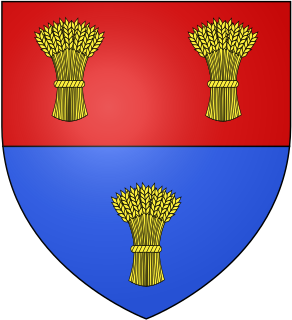
William de Braose,, 4th Lord of Bramber, court favourite of King John of England, at the peak of his power, was also Lord of Gower, Abergavenny, Brecknock, Builth, Radnor, Kington, Limerick, Glamorgan, Skenfrith, Briouze in Normandy, Grosmont, and White Castle.

Richard Beauchamp, 13th Earl of Warwick was an English medieval nobleman and military commander.
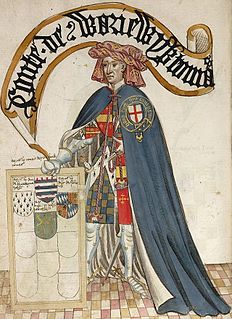
Thomas de Beauchamp, 11th Earl of Warwick, KG was an English nobleman and military commander during the Hundred Years' War. His reputation as a military leader was so formidable that he was nicknamed 'the devil Warwick' by the French. In 1348 he became one of the founders and the third Knight of the Order of the Garter.
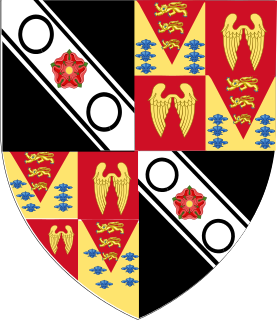
The titles of Earl of Hertford and Marquess of Hertford have been created several times in the peerages of England and Great Britain.

Marquess of Abergavenny in the County of Monmouth, is a title in the Peerage of the United Kingdom that was created on 14 January 1876, along with the title Earl of Lewes, in the County of Sussex, for the 5th Earl of Abergavenny, a member of the Nevill family.
The title Baron Bergavenny was created several times in the Peerage of England and once in the Peerage of Great Britain, all but the first being baronies created by error. Abergavenny is a market town in South East Wales with a castle established by the Norman lord Hamelin de Balun c. 1087.
Gwladus Ddu,, full name Gwladus ferch Llywelyn was a Welsh noblewoman who was a daughter of Llywelyn the Great of Gwynedd and Joan Plantagenet, a daughter of John, King of England. She married two Marcher lords.

Richard de Beauchamp, 1st Earl of Worcester, KB was an English peer.

William de Beauchamp, 1st Baron Bergavenny, KG was an English peer.

Abergavenny Castle is a ruined castle in the market town of Abergavenny, Monmouthshire, Wales, established by the Norman lord Hamelin de Balun c. 1087. It was the site of a massacre of Welsh noblemen in 1175, and was attacked during the early 15th-century Glyndŵr Rising. William Camden, the 16th-century antiquary, said that the castle "has been oftner stain'd with the infamy of treachery, than any other castle in Wales."
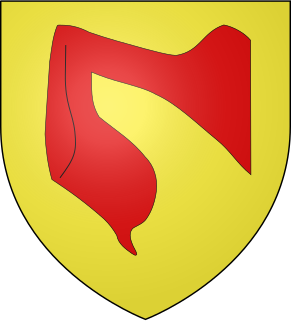
John Hastings, 1st Baron Hastings, feudal Lord of Abergavenny, was an English peer and soldier. He was one of the Competitors for the Crown of Scotland in 1290/92 in the Great Cause and signed and sealed the Barons' Letter of 1301.
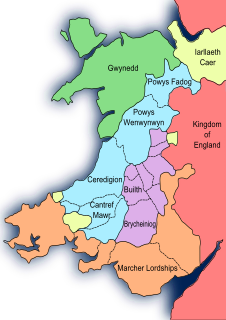
The Lordship of Glamorgan was one of the most powerful and wealthy of the Welsh Marcher Lordships. The seat was Cardiff Castle. It was established by the conquest of Glamorgan from its native Welsh ruler, by the Anglo-Norman nobleman Robert FitzHamon, feudal baron of Gloucester, and his legendary followers the Twelve Knights of Glamorgan. The Anglo-Norman Lord of Glamorgan, like all Marcher lords, ruled his lands directly by his own law: thus he could, amongst other things, declare war, raise taxes, establish courts and markets and build castles as he wished, without reference to the Crown. These privileges were only lost under the Laws in Wales Acts 1535–1542. Though possessing many castles, the main seat of the Lordship was Cardiff Castle.

Hamelin de Ballon, (b ca. 1060, died 5 March 1105/6, was an early Norman Baron and the first Baron Abergavenny and Lord of Over Gwent and Abergavenny; he also served William Rufus.
Seisyll ap Dyfnwal was a 12th-century Welsh Lord of Gwent Uwchcoed.
Henry FitzMiles, Baron Abergavenny was a Norman baron and a Marcher Lord in the Welsh Marches.

William de Beauchamp, 9th Earl of Warwick was the eldest of eight children of William de Beauchamp of Elmley and his wife Isabel de Mauduit. He was an English nobleman and soldier, described as a “vigorous and innovative military commander." He was active in the field against the Welsh for many years, and at the end of his life campaigned against the Scots.

Katherine Mortimer, Countess of Warwick was the wife of Thomas de Beauchamp, 11th Earl of Warwick KG, an English peer, and military commander during the Hundred Years War. She was a daughter and co-heiress of Roger Mortimer, 1st Earl of March and Joan de Geneville, Baroness Geneville.
Alice de Toeni, Countess of Warwick was a wealthy English heiress and the second wife of Guy de Beauchamp, 10th Earl of Warwick, an English nobleman in the reign of Kings Edward I and Edward II. He was one of the principal opponents of Piers Gaveston, a favourite of Edward II of England. Alice married three times; Guy was her second husband.

The site of Castell Arnallt, sometimes known as Castle Arnold, is located near the village of Llanover in the Usk valley of Monmouthshire, Wales, some 4 miles (6.4 km) south east of Abergavenny. It was the fortified court house, or llys, of Seisyll ap Dyfnwal, lord of Over Gwent or Gwent Uwchcoed, before it was destroyed after Seisyll and some of his household were killed at Abergavenny Castle by William de Braose in 1175. The land is now in agricultural use, with no remains visible.













